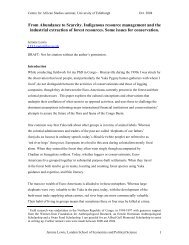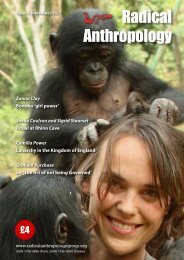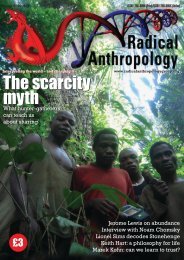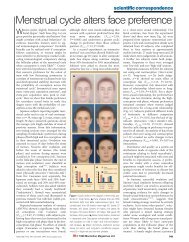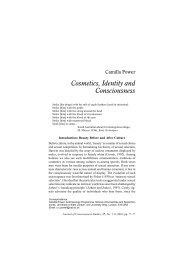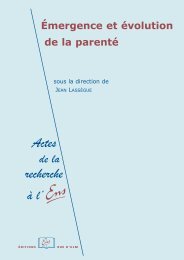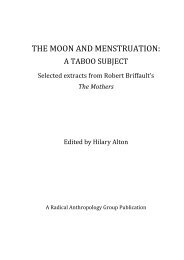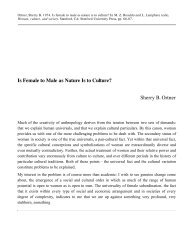Locke & Bogin: <str<strong>on</strong>g>Language</str<strong>on</strong>g> <str<strong>on</strong>g>and</str<strong>on</strong>g> <str<strong>on</strong>g>life</str<strong>on</strong>g> <str<strong>on</strong>g>history</str<strong>on</strong>g><strong>the</strong>ir speech striking listeners as slow <str<strong>on</strong>g>and</str<strong>on</strong>g> m<strong>on</strong>ot<strong>on</strong>ous(Felsenfeld et al. 1992).Findings in behavioral <str<strong>on</strong>g>and</str<strong>on</strong>g> molecular genetics alsosupport links between language <str<strong>on</strong>g>and</str<strong>on</strong>g> speech, whilehinting at previously unexamined c<strong>on</strong>tributi<strong>on</strong>s ofspeech to o<strong>the</strong>r linguistic domains. In studies of m<strong>on</strong>ozygotic<str<strong>on</strong>g>and</str<strong>on</strong>g> dizygotic twins, for example, <strong>the</strong> highest ratesof c<strong>on</strong>cordance have come from twins in whom <strong>the</strong> disorderwas primarily expressive; some had disorders that werepurely of <strong>the</strong> articulatory type (Bishop et al. 1995; Lewis1990; Lewis & Thomps<strong>on</strong> 1992). In typically developing7- to 13-year-old children, Bishop (2001) also found thatMZ twins were more c<strong>on</strong>cordant than DZ twins <strong>on</strong> rateof speeded articulati<strong>on</strong> of polysyllabic words. These findingsseem to fit with <strong>the</strong> possibility that selecti<strong>on</strong> acted<strong>on</strong> performance, thus <strong>on</strong> factors relating to precisi<strong>on</strong>,speed, complexity, <str<strong>on</strong>g>and</str<strong>on</strong>g> fluency of articulati<strong>on</strong>. In doingso, it may have reinforced those behaviors, indirectlyenhancing related acquisiti<strong>on</strong>s <str<strong>on</strong>g>and</str<strong>on</strong>g> <strong>development</strong>s thathad occurred earlier in <strong>development</strong>.The role played by producti<strong>on</strong> factors has also beenhighlighted by studies of a particular family in Engl<str<strong>on</strong>g>and</str<strong>on</strong>g>.In <strong>the</strong> early 1990s, researchers discovered <strong>the</strong> KE family,which had serious communicati<strong>on</strong> disorders at each of itsthree living generati<strong>on</strong>s. Although <strong>the</strong>se problemsincluded a severe oral <str<strong>on</strong>g>and</str<strong>on</strong>g> verbal dyspraxia, accompaniedby deficits at o<strong>the</strong>r levels of language (Fletcher 1990;Hurst et al. 1990; Vargha-Khadem 1990), a grammaticallyfocused investigati<strong>on</strong> of <strong>the</strong> family found precisely what itwas looking for: grammatical problems (Gopnik 1990;Gopnik & Crago 1991). Nearly a decade later, geneticistsfound a defective gene in <strong>the</strong> family, FOXP2, which is situated<strong>on</strong> <strong>the</strong> l<strong>on</strong>g arm of chromosome 7 (Lai et al. 2000;2001). But, in parallel with <strong>the</strong> genetics work, o<strong>the</strong>rteams of clinical investigators c<strong>on</strong>firmed <strong>the</strong> dyspraxicdisorder, which involved both speech <str<strong>on</strong>g>and</str<strong>on</strong>g> n<strong>on</strong>speechmovements of <strong>the</strong> articulators (Vargha-Khadem et al.1995; 1998). In functi<strong>on</strong>al imaging studies, affectedfamily members revealed significant underactivati<strong>on</strong> ofBroca’s area in both hemispheres, c<strong>on</strong>sistent with adeficit of speech producti<strong>on</strong> (Liégeous et al. 2003).What is relevant here is that <strong>the</strong> primary problem of <strong>the</strong>KE family was rec<strong>on</strong>ceptualized as an oral-motor difficultythat was accompanied by grammatical difficulties. Several<strong>the</strong>orists toyed with <strong>the</strong> idea that <strong>the</strong> KE family’s oralmotordifficulties caused <strong>the</strong>ir grammatical <str<strong>on</strong>g>and</str<strong>on</strong>g> comprehensi<strong>on</strong>difficulties. “One possibility,” wrote Watkinset al. (2002), “is that <strong>the</strong> deviant articulati<strong>on</strong> results inpoor ph<strong>on</strong>ology, rendering morphological producti<strong>on</strong>difficult” (p. 461). “It might be <strong>the</strong> case,” Marcus <str<strong>on</strong>g>and</str<strong>on</strong>g>Fisher (2003) speculated, “that a deficit restricted to <strong>the</strong>motor system is fully resp<strong>on</strong>sible for <strong>the</strong> wide-rangingprofile of impairment” (p. 261). There could have been a“flow-<strong>on</strong> effect from articulati<strong>on</strong> to syntax to comprehensi<strong>on</strong>,”wrote Corballis (2004, p. 548).How did our ancestors get from articulated ph<strong>on</strong>ati<strong>on</strong> tosyntax? According to Bickert<strong>on</strong> (2000):The ability to make <str<strong>on</strong>g>and</str<strong>on</strong>g> distinguish a greater range of speechsounds would make possible a wider variety of sound combinati<strong>on</strong>s,which, given a larger <str<strong>on</strong>g>and</str<strong>on</strong>g> more efficient memory forwords, would give rise to a steadily increasing vocabulary.Undoubtedly, <strong>the</strong>se factors <str<strong>on</strong>g>and</str<strong>on</strong>g> processes would have combinedto yield a much richer means of communicati<strong>on</strong>am<strong>on</strong>g hominins. (p. 157)This would not automatically produce syntax, asBickert<strong>on</strong> noted, but it may have led to o<strong>the</strong>r changesthat favored ph<strong>on</strong>ology, beginning with <strong>the</strong> ritualizati<strong>on</strong>of vocal patterns (Locke 2004a; in press b; Oller 2004;Richman 2000) <str<strong>on</strong>g>and</str<strong>on</strong>g> ultimately <strong>the</strong>ir segmentati<strong>on</strong> intodiscrete linguistic units (Studdert-Kennedy 1998; 2005;Studdert-Kennedy & Goldstein 2003).12. What bel<strong>on</strong>gs in <strong>the</strong> language faculty?Evidence examined earlier revealed c<strong>on</strong>tinuity between<strong>the</strong> lexical delays of infancy – even where <strong>the</strong>y appearedto resolve – <str<strong>on</strong>g>and</str<strong>on</strong>g> <strong>the</strong> pragmatic <str<strong>on</strong>g>and</str<strong>on</strong>g> performative problemsof adolescence. If we attempt to account for this c<strong>on</strong>tinuity,two possibilities emerge immediately. Accordingto <strong>the</strong> first, pragmatics <str<strong>on</strong>g>and</str<strong>on</strong>g> performance are social applicati<strong>on</strong>sof linguistic knowledge, <str<strong>on</strong>g>and</str<strong>on</strong>g> thus depend <strong>on</strong> thatknowledge. This could explain <strong>the</strong> <strong>development</strong>al associati<strong>on</strong>between scores <strong>on</strong> st<str<strong>on</strong>g>and</str<strong>on</strong>g>ard tests of language <str<strong>on</strong>g>and</str<strong>on</strong>g>experimental measures of pragmatics.A more satisfying possibility is that delayed lexical <strong>development</strong>points to a weakened faculty of language, sinceeven <strong>the</strong> earliest use of words requires <strong>the</strong> acti<strong>on</strong> of mechanismsthat bel<strong>on</strong>g to this faculty. This is c<strong>on</strong>sistent with aparadox about language <strong>development</strong>. Infants rarely vocalizeat normal levels of frequency <str<strong>on</strong>g>and</str<strong>on</strong>g> complexity during<strong>the</strong> babbling stage; <strong>the</strong>y imitate aspects of <strong>the</strong>ir mo<strong>the</strong>r’sspeech <str<strong>on</strong>g>and</str<strong>on</strong>g> produce isolated words – behaviors thatostensibly require no grammatical ability at all – <str<strong>on</strong>g>and</str<strong>on</strong>g><strong>the</strong>n stumble as <strong>the</strong>y enter <strong>the</strong> domains of morphology<str<strong>on</strong>g>and</str<strong>on</strong>g> syntax (Locke 1998a). Whatever problems arise at<strong>the</strong> grammatical level of language are typically forecastby deficiencies in early lexical <strong>development</strong> (Bates &Goodman 1997), <str<strong>on</strong>g>and</str<strong>on</strong>g> possibly even <strong>the</strong> precursors toword learning (Oller et al. 1999). These facts suggestthat <strong>the</strong> earlier <str<strong>on</strong>g>and</str<strong>on</strong>g> later behaviors, as different as <strong>the</strong>yare, bel<strong>on</strong>g to a system of linked neural resources, <str<strong>on</strong>g>and</str<strong>on</strong>g>that weakness in <strong>the</strong> expressi<strong>on</strong> of an early comp<strong>on</strong>entindexes weakness in o<strong>the</strong>rs, including <strong>the</strong> performativeareas that happen to develop late. According to this explanati<strong>on</strong>,early lexical delay predicts problems of usage <str<strong>on</strong>g>and</str<strong>on</strong>g>interpretati<strong>on</strong> in adolescence even if <strong>the</strong> delay, by testsof structure <str<strong>on</strong>g>and</str<strong>on</strong>g> c<strong>on</strong>tent, seems to resolve l<strong>on</strong>g beforethat stage. The sec<strong>on</strong>d account is <strong>the</strong>refore able toh<str<strong>on</strong>g>and</str<strong>on</strong>g>le problems of interpretati<strong>on</strong> as well as usage.At first glance, it may seem adventurous to assign lexical<strong>development</strong> to <strong>the</strong> same faculty as o<strong>the</strong>r comp<strong>on</strong>ents oflanguage. For lexical <strong>development</strong> rests <strong>on</strong> a number ofperceptual, attenti<strong>on</strong>al, <str<strong>on</strong>g>and</str<strong>on</strong>g> o<strong>the</strong>r cognitive systems thatare not, in <str<strong>on</strong>g>and</str<strong>on</strong>g> of <strong>the</strong>mselves, linguistic. But a wider <str<strong>on</strong>g>perspective</str<strong>on</strong>g><strong>on</strong> <strong>the</strong> faculty of language has recently becomeavailable. In an attempted rec<strong>on</strong>ciliati<strong>on</strong> of evoluti<strong>on</strong>arybiology <str<strong>on</strong>g>and</str<strong>on</strong>g> linguistics, Hauser, Chomsky, <str<strong>on</strong>g>and</str<strong>on</strong>g> Fitchhave proposed a broad linguistic faculty that extendsbey<strong>on</strong>d a narrow computati<strong>on</strong>al core to include <strong>the</strong> “biologicalcapacity of humans that allows us (<str<strong>on</strong>g>and</str<strong>on</strong>g> not, forexample, chimpanzees) to readily master any humanlanguage without explicit instructi<strong>on</strong>” (Hauser et al.2002, p. 1571; also see Fitch et al. 2005).The broad model offered by Hauser <str<strong>on</strong>g>and</str<strong>on</strong>g> colleaguesoffers hope to those who might like to see linguistic knowledge<str<strong>on</strong>g>and</str<strong>on</strong>g> structure accommodated under <strong>the</strong> same<strong>the</strong>oretical roof as pragmatics <str<strong>on</strong>g>and</str<strong>on</strong>g> verbal performance.276 BEHAVIORAL AND BRAIN SCIENCES (2006) 29:3
Locke & Bogin: <str<strong>on</strong>g>Language</str<strong>on</strong>g> <str<strong>on</strong>g>and</str<strong>on</strong>g> <str<strong>on</strong>g>life</str<strong>on</strong>g> <str<strong>on</strong>g>history</str<strong>on</strong>g>If <strong>development</strong>al evidence suggests that some pragmaticabilities st<str<strong>on</strong>g>and</str<strong>on</strong>g> in closer relati<strong>on</strong>ship to lexical <str<strong>on</strong>g>and</str<strong>on</strong>g> grammaticalknowledge than o<strong>the</strong>rs, as it does (McTear & C<strong>on</strong>ti-Ramsden 1992), <strong>the</strong>n <strong>the</strong> faculty of language shouldinclude <strong>the</strong>se related, <str<strong>on</strong>g>and</str<strong>on</strong>g> possibly interdependent,specializati<strong>on</strong>s. Certainly <strong>the</strong> evoluti<strong>on</strong>ary accountoffered here suggests that it should. For, if pragmatic<str<strong>on</strong>g>and</str<strong>on</strong>g> performative abilities were selected, it is hard to seehow <strong>the</strong>y could have escaped some degree of integrati<strong>on</strong>with earlier linguistic <strong>development</strong>s <strong>on</strong> which <strong>the</strong>y wouldhave depended.What bel<strong>on</strong>gs in <strong>the</strong> language faculty is a matter thatshould ultimately be decided empirically, based <strong>on</strong> evidenceof various sorts, including lesi<strong>on</strong>, imaging, <str<strong>on</strong>g>and</str<strong>on</strong>g> processingstudies, even if <strong>the</strong> interpretati<strong>on</strong> of some findingsproves problematic (Thomas & Karmiloff-Smith 2002).Here, we rely <strong>on</strong> normal <str<strong>on</strong>g>and</str<strong>on</strong>g> atypical patterns of <strong>development</strong>,<str<strong>on</strong>g>and</str<strong>on</strong>g> an additi<strong>on</strong>al line of argument <str<strong>on</strong>g>and</str<strong>on</strong>g> evidence –evoluti<strong>on</strong> itself. For <strong>the</strong> traits that are present in modernhumans are traits that evolved. If language evolved, <strong>the</strong>n<strong>the</strong> comp<strong>on</strong>ents of language were selected. If selecti<strong>on</strong>applied to behaviors affecting care in infancy <str<strong>on</strong>g>and</str<strong>on</strong>g> childhood,<str<strong>on</strong>g>and</str<strong>on</strong>g> competiti<strong>on</strong> in juvenility <str<strong>on</strong>g>and</str<strong>on</strong>g> adolescence,<strong>the</strong>n <strong>the</strong> behaviors that were selected during <strong>the</strong>sestages would now be included in <strong>the</strong> trait. The net resultwould be a series of functi<strong>on</strong>al interrelati<strong>on</strong>ships, since<strong>the</strong> behaviors that appeared early enabled later <strong>development</strong>s,which, in turn, reinforced <strong>the</strong>ir own precursors.Thus, <strong>the</strong> human faculty of language would extendbey<strong>on</strong>d <strong>the</strong> ability to learn a linguistic code <str<strong>on</strong>g>and</str<strong>on</strong>g> to use itsimply to inform; it would extend to <strong>the</strong> ability to speakskillfully so as to compete <str<strong>on</strong>g>and</str<strong>on</strong>g> cooperate in social <str<strong>on</strong>g>and</str<strong>on</strong>g>sexual maturity.13. Vocal <strong>on</strong>togeny, linguistic phylogenyWe have discussed selecti<strong>on</strong> as it may have applied inadolescence <str<strong>on</strong>g>and</str<strong>on</strong>g> adulthood, but have additi<strong>on</strong>allyproposed a role for infants <str<strong>on</strong>g>and</str<strong>on</strong>g> children – <str<strong>on</strong>g>and</str<strong>on</strong>g> <strong>the</strong>irparents – <str<strong>on</strong>g>and</str<strong>on</strong>g> a role for juveniles. In doing so, we haveintroduced proto-linguistic c<strong>on</strong>tent to two pre-existingc<strong>on</strong>cepti<strong>on</strong>s of evoluti<strong>on</strong>, <strong>on</strong>e relating to <strong>the</strong> role of <strong>development</strong>,<strong>the</strong> o<strong>the</strong>r to <strong>the</strong> role of behavior. The suggesti<strong>on</strong>that <strong>development</strong> plays a role in evoluti<strong>on</strong> was raised byMivart (1871) <str<strong>on</strong>g>and</str<strong>on</strong>g> developed by Garstang (1922), whoargued that <strong>on</strong>togeny was no “animated cinema show ofancestral portraits” (p. 100), as Haeckel had claimed inhis late nineteenth century recapitulatory doctrine, butactually plays a reverse role by “creating” evoluti<strong>on</strong>. 18Gould (1977) <str<strong>on</strong>g>and</str<strong>on</strong>g> Gottlieb (1992) have discussed <strong>development</strong>alc<strong>on</strong>tributi<strong>on</strong>s to evoluti<strong>on</strong> in some detail, <strong>the</strong> latteralso claiming, after Bates<strong>on</strong> (1988), that individuals’behaviors play a central role in evoluti<strong>on</strong>, especiallywhen <strong>the</strong>y move about <str<strong>on</strong>g>and</str<strong>on</strong>g> thus alter <strong>the</strong>ir envir<strong>on</strong>ment. 19Gottlieb (1992) offered a three-stage model of <strong>the</strong>process by which <str<strong>on</strong>g>new</str<strong>on</strong>g> behavioral <strong>development</strong>s produceevoluti<strong>on</strong>ary change. In <strong>the</strong> first stage, a modificati<strong>on</strong> of<strong>development</strong>al c<strong>on</strong>diti<strong>on</strong>s forces a previously unexpressedbehavior to <strong>the</strong> surface, followed in <strong>the</strong> sec<strong>on</strong>d stage bymorphological <str<strong>on</strong>g>and</str<strong>on</strong>g> physiological alterati<strong>on</strong>s, <str<strong>on</strong>g>and</str<strong>on</strong>g>, in <strong>the</strong>final stage, by a change in <strong>the</strong> genetic compositi<strong>on</strong> of <strong>the</strong>populati<strong>on</strong>. If we apply Gottlieb’s model here, bipedalismis seen as a key event in Stage I, for this was a <str<strong>on</strong>g>new</str<strong>on</strong>g> behaviorthat, in time, produced pelvic narrowing. Remodeling of<strong>the</strong> birth canal caused a shift of skull <str<strong>on</strong>g>and</str<strong>on</strong>g> brain <strong>development</strong>into <strong>the</strong> postnatal period, increasing <strong>the</strong> degree<str<strong>on</strong>g>and</str<strong>on</strong>g> durati<strong>on</strong> of infant helplessness. When weaningwas brought forward <str<strong>on</strong>g>and</str<strong>on</strong>g> sibling competiti<strong>on</strong> increased,infants – at an age when <strong>the</strong>ir brain was developingrapidly – experienced additi<strong>on</strong>al pressures to do thingsthat would preserve <strong>the</strong> flow of care. In Stage II,hominin infants exploited pre-existing but quiescentmeans of signaling <strong>the</strong>ir needs to, <str<strong>on</strong>g>and</str<strong>on</strong>g> appraising <strong>the</strong> reacti<strong>on</strong>sof, heavily burdened caregivers, some doing so moreeffectively than o<strong>the</strong>rs. In <strong>the</strong> final stage of evoluti<strong>on</strong>arychange, Stage III, <strong>the</strong> capacity to produce more complexvocalizati<strong>on</strong>s made its way through <strong>the</strong> populati<strong>on</strong>, acquiringa genetic foundati<strong>on</strong>.In <strong>the</strong> example above, evoluti<strong>on</strong>ary change applied to<strong>the</strong> earliest stage of <str<strong>on</strong>g>life</str<strong>on</strong>g> <str<strong>on</strong>g>history</str<strong>on</strong>g>, but infants who achievedeffective care <str<strong>on</strong>g>and</str<strong>on</strong>g> engagement signals would havecarried some form of <strong>the</strong> relevant c<strong>on</strong>trol behaviors intochildhood, juvenility, <str<strong>on</strong>g>and</str<strong>on</strong>g> adolescence, where <strong>the</strong>yenabled additi<strong>on</strong>al capabilities – skills that facilitated,am<strong>on</strong>g o<strong>the</strong>r things, <strong>the</strong> quest for status, sex, <str<strong>on</strong>g>and</str<strong>on</strong>g>additi<strong>on</strong>al resources. The <str<strong>on</strong>g>new</str<strong>on</strong>g> skills were reinforced byreproductive success, automatically streng<strong>the</strong>ning, in asec<strong>on</strong>d hit, <strong>the</strong> precursors that had persisted in someform from earlier stages. In doing so, comp<strong>on</strong>ents <str<strong>on</strong>g>and</str<strong>on</strong>g>specific applicati<strong>on</strong>s of <strong>the</strong> human voice became cues tofitness <str<strong>on</strong>g>and</str<strong>on</strong>g> a genetic specializati<strong>on</strong> emerged, <strong>on</strong>e thatwould direct <strong>the</strong> <strong>development</strong>, learning, <str<strong>on</strong>g>and</str<strong>on</strong>g> strategicuse of complex vocalizati<strong>on</strong>s in future generati<strong>on</strong>s.The <strong>development</strong>al c<strong>on</strong>diti<strong>on</strong>s that favored evoluti<strong>on</strong> ofvocal-motor c<strong>on</strong>trol in infancy – helplessness <str<strong>on</strong>g>and</str<strong>on</strong>g> dependency– would also have promoted perceptual sensitivity<str<strong>on</strong>g>and</str<strong>on</strong>g> nurturance in caregivers. For, with more competingoffspring to care for, mo<strong>the</strong>rs were forced to discriminateh<strong>on</strong>est cries from bogus distress signals (now more plentiful<str<strong>on</strong>g>and</str<strong>on</strong>g> clever than ever) <str<strong>on</strong>g>and</str<strong>on</strong>g> to infer signs of physical <str<strong>on</strong>g>and</str<strong>on</strong>g>social maturati<strong>on</strong> from o<strong>the</strong>r vocal cues. They were alsoforced to provide more intensive care to individualinfants. There would have been a range of variati<strong>on</strong> in<strong>the</strong> dispositi<strong>on</strong> or ability to carry out <strong>the</strong>se functi<strong>on</strong>s,too, with selecti<strong>on</strong> acting <strong>on</strong> <strong>the</strong> genetic correlates ofpercepti<strong>on</strong> <str<strong>on</strong>g>and</str<strong>on</strong>g> care.14. C<strong>on</strong>cluding remarksThe <str<strong>on</strong>g>life</str<strong>on</strong>g> <str<strong>on</strong>g>history</str<strong>on</strong>g> approach taken here has produced severalobservati<strong>on</strong>s, speculati<strong>on</strong>s, <str<strong>on</strong>g>and</str<strong>on</strong>g> c<strong>on</strong>clusi<strong>on</strong>s. We began byreiterating an earlier speculati<strong>on</strong> that a brief childhoodwas inserted into <strong>the</strong> hominin line around <strong>the</strong> time ofH. habilis, offering reproductive benefits to mo<strong>the</strong>rs. We<strong>the</strong>n speculated that childhood would have facilitated<strong>the</strong> evoluti<strong>on</strong> of language by extending parental investmentto <strong>the</strong>ir offspring during a period of intense symboliccreativity <str<strong>on</strong>g>and</str<strong>on</strong>g> increasing aut<strong>on</strong>omy. Noting that manyevoluti<strong>on</strong>ary <strong>the</strong>ories are built <strong>on</strong> skeletal remains, wesuggested that a <str<strong>on</strong>g>life</str<strong>on</strong>g> <str<strong>on</strong>g>history</str<strong>on</strong>g> approach to language – abehavior that relies <strong>on</strong> soft tissues – makes additi<strong>on</strong>altypes of evidence available, including findings <strong>on</strong> bipedalism<str<strong>on</strong>g>and</str<strong>on</strong>g> pelvic narrowing, c<strong>on</strong>tinuati<strong>on</strong> of rapid braingrowth after birth, growth of l<strong>on</strong>g b<strong>on</strong>es, <str<strong>on</strong>g>and</str<strong>on</strong>g> dentiti<strong>on</strong>.Selecti<strong>on</strong> of linguistically relevant behaviors that occurin infancy, childhood, <str<strong>on</strong>g>and</str<strong>on</strong>g> juvenility (stages that areBEHAVIORAL AND BRAIN SCIENCES (2006) 29:3 277



